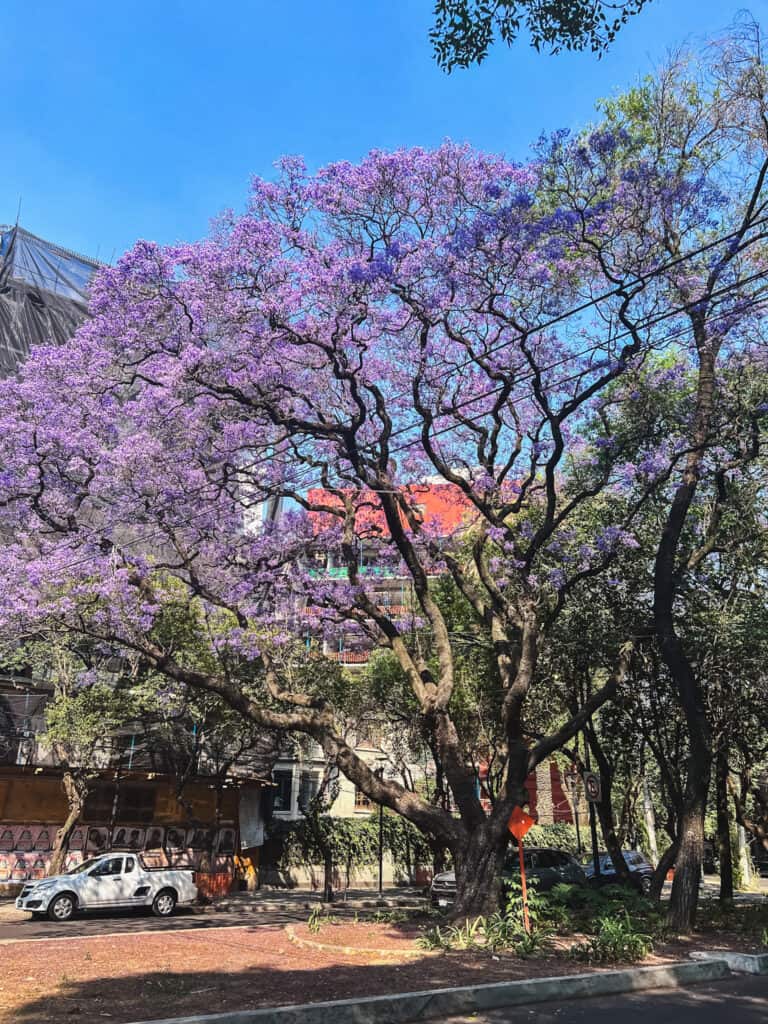Driving in Costa Rica: Everything I wish I Knew Ahead of Time
If you’re wondering what driving in Costa Rica is like as a tourist, I’ve got you covered.
I recently enjoyed 3 weeks of adventures in Costa Rica and I absolutely fell in love with the country. The tropical animals, the beautiful nature, the hot springs, the calm beaches – what’s not to love? There are so many incredible places and activities to explore, but you have to get there somehow.
From road conditions (unpredictable) to whether or not you need four wheel drive (probably) to Costa Rica car rental insurance (annoying), I’ll break down all the questions I had before leaving and what I wish I’d known now that I’ve done it.
Running short on time? Here’s a quick guide of everything you need to know for driving in Costa Rica:
Is it Safe to Drive in Costa Rica?
- Yes, I felt safe and the rules and roadsigns are quite similar to the states. But the roads are unpaved so be prepared for serious off-roading.
Do you need an SUV or 4×4?
- You absolutely need an SUV and I’d recommend a 4×4 to err on the safe side.
Where should you rent a car?
- You can find solid deals here on DiscoverCars. BUT be sure to google the rental company name to read reviews and beware when it’s “too cheap”. Go for chains you recognize (I used Avis) or Adobe (a local favorite).
Can you use shuttles instead?
- Absolutely! Shuttles travel major routes throughout the country. See here for shuttles with great reviews or check out Interbus.
Driving in Costa Rica: What to Expect
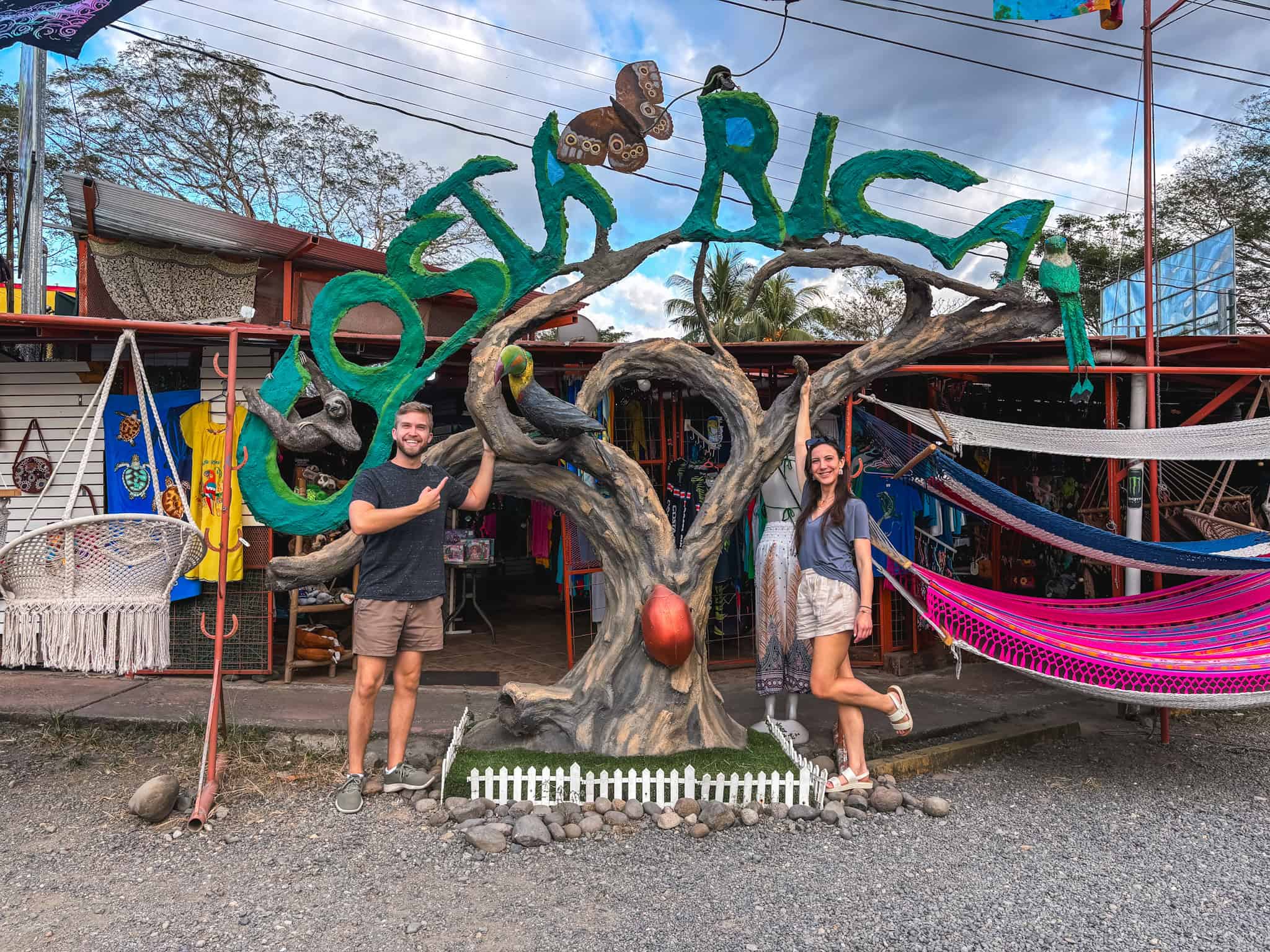
Driving in Costa Rica is an adventure, but a doable one.
- Driving Basics: You drive on the right hand side of the road and roadsigns often include English translations.
The speed limits were reasonable and usually respected – it honestly felt like driving in the states. That being said, motorcycles weave in and out of lanes pretty extensively. You’ll need to keep an eye out before you do any lane changes or turns. - Traffic: Expect some serious traffic around the San José airport, especially once you hit the afternoon or evening time. For us, we left San José around noon for a supposedly three hour drive to Uvita and it took us close to 6 hours. This was driven primarily by traffic leaving San José and a few construction stops closer to Uvita.
- Road Conditions: I’ll delve more into this, but generally highways are paved and driving between major cities is easy. However, if you’re looking at Google Maps and your route has many tiny curves, it’s probably unpaved (I learned this the hard way on my drive from La Fortuna to Santa Teresa). While you may not need four wheel drive everywhere, I would strongly recommend getting an SUV.
- Especially if you’re staying somewhere with a viewpoint, it’s likely the drive up to the house is on a fairly rough road. Be sure to check with your hotel or Airbnb host about what the conditions are like.
- Especially if you’re staying somewhere with a viewpoint, it’s likely the drive up to the house is on a fairly rough road. Be sure to check with your hotel or Airbnb host about what the conditions are like.
- Toll Roads are common and you can pay a few dollars with cash (dollars or colones) or card.
- Gas stations are full-service – An attendant will pump gas for you, so no need to get out of the car. You do want to ensure the price gauge is at zero before they start pumping and double check your total before you pay, there have been some scams around this.
Costa Rica Drivers License Requirements
As an American, you don’t need an international drivers license to drive in Costa Rica. If you have a license with Latin characters, you’re good to go. If it has alternate lettering (e.g. Japanese) you will need an international drivers license.
Should You Rent a Car in Costa Rica?
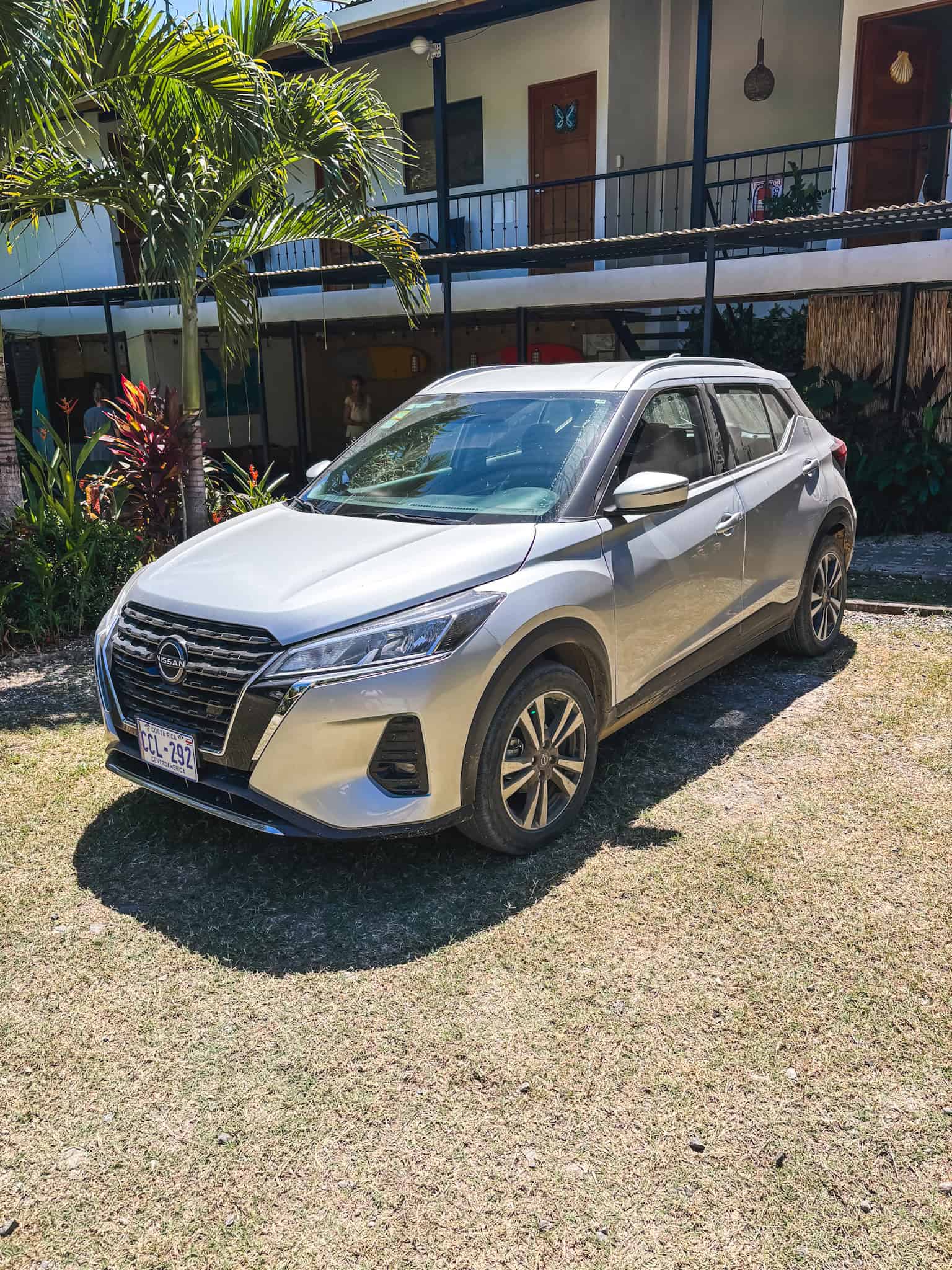
This really depends on how much flexibility you want. I did both, taking a shuttle to Uvita but picking up a car for our time in La Fortuna and Santa Teresa. Given our trip duration and the long drives we had planned, I ended up liking the flexibility of having a car and being able to go at my own pace.
I highly recommend booking a car in advance as prices can get pretty intense. I have more on renting a car later in this guide, but DiscoverCars has solid deals, you just want to make sure you google the company ahead of time to read reviews.
That being said, shuttles are very common in Costa Rica through companies like Interbus and you can easily book a spot.
If you’re sticking to one destination (like Manuel Antonio or Santa Teresa) and don’t plan on taking many day trips, a shuttle or private transfer might be the more relaxing option. But if you want to visit multiple areas, explore hidden beaches, or drive up to scenic Airbnbs, a rental car is a game-changer.
Pros of Renting a Car in Costa Rica
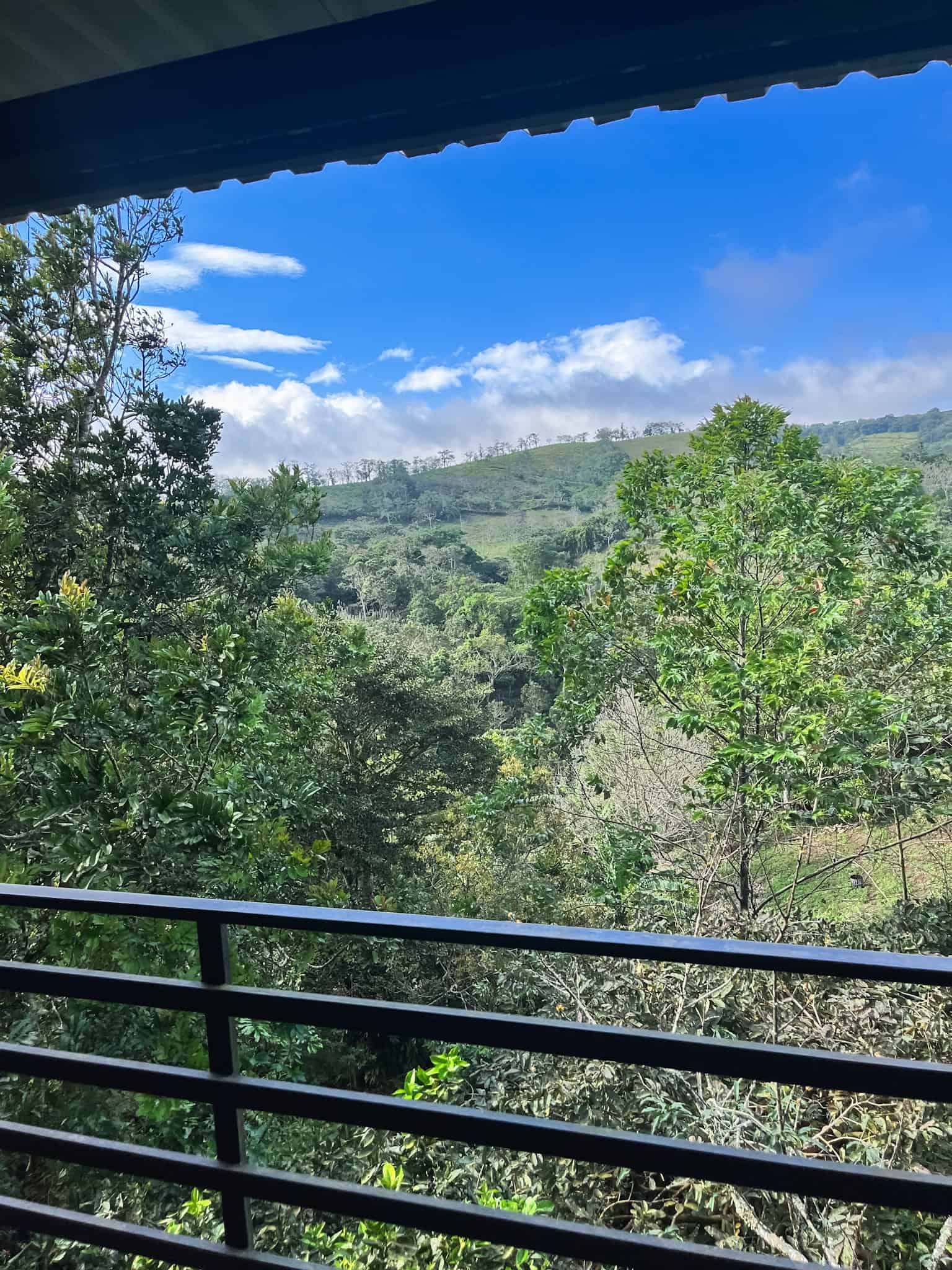
✔ Freedom & Flexibility – You won’t be tied to shuttle schedules (which often pick up at 6:30am). Want to stop at a roadside fruit stand or take a spontaneous detour to a waterfall? No problem. I loved stopping at Espresso Cafe for lunch and a viewpoint on our way to La Fortuna.
✔ Better for remote locations – Many of Costa Rica’s best spots (hidden beaches, jungle lodges, and waterfalls) are only accessible by car.
✔ Saves money on tours & transfers – Shuttles and taxis add up fast, especially if you’re visiting multiple destinations. That being said, having a tour guide for your activities in Costa Rica will help you learn a lot more (and they’re better at spotting wild animals!).
✔ Taxis and Ubers aren’t always available – In many areas (especially beach towns like Santa Teresa or rural locations), taxis can be scarce and Ubers may not operate at all. Having your own car ensures you won’t be stranded or waiting forever for a ride. We booked a taxi over Whatsapp one night in Santa Teresa and it never showed up 🤷♀️
Cons of Renting a Car in Costa Rica
🚧 Driving conditions can be unpredictable – Unpaved roads, potholes, and river crossings can be challenging, especially in the rainy season. If you’re not comfortable with rocky terrain, a shuttle is a great option (I’ll recommend a few companies later on).
🚧 Expensive insurance – Car rental insurance in Costa Rica is mandatory and pricey (more on that below).
🚧 Traffic in major cities – If you’re driving in San José, expect heavy traffic, somewhat aggressive drivers, and mildly confusing road layouts. This wouldn’t disappear in a shuttle, but you wouldn’t have to worry about navigating it yourself
Is it Safe Driving in Costa Rica?
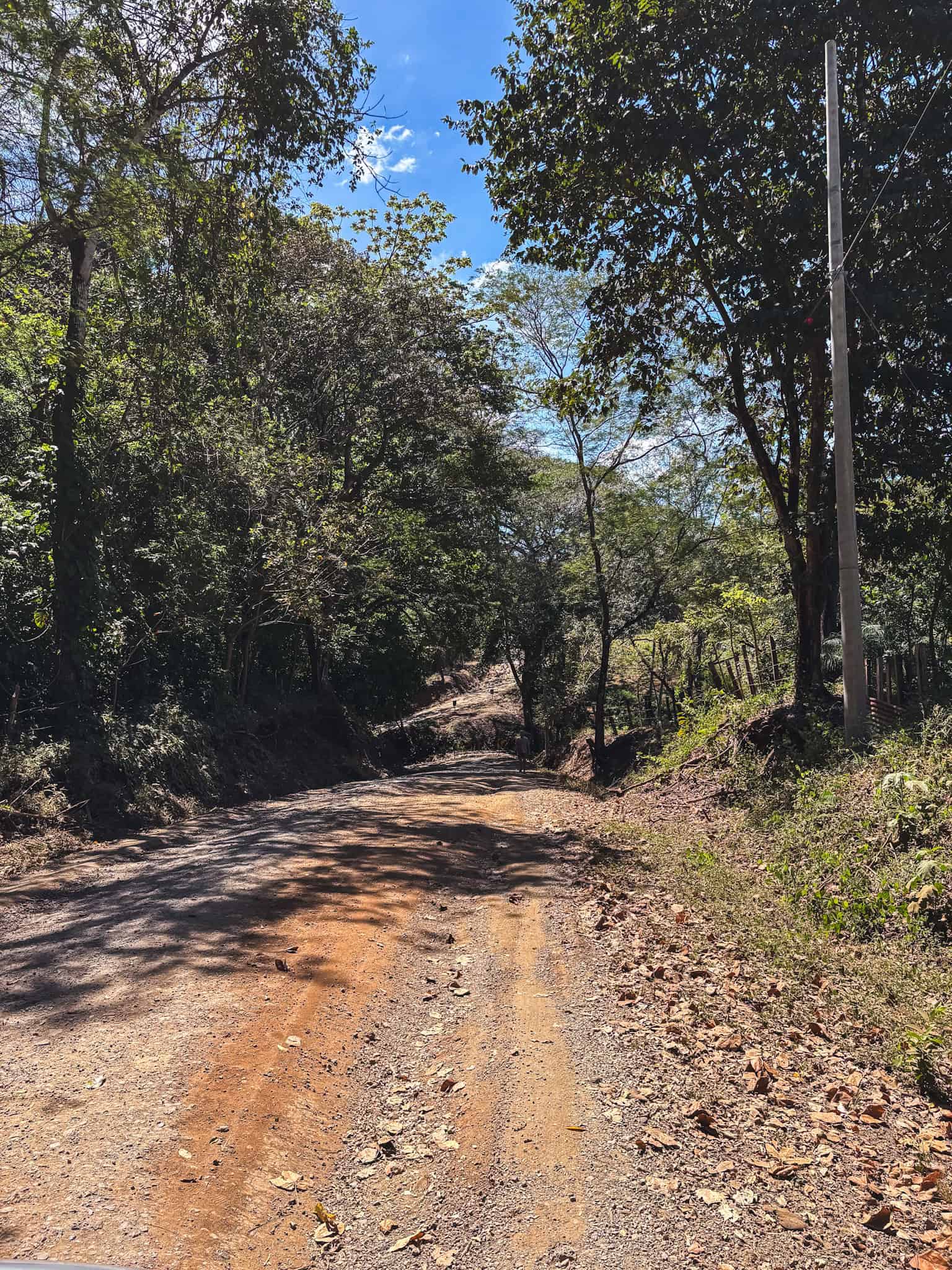
I honestly felt safer driving in Costa Rica than in Paris, but the roads were far more unpredictable. The speeds were pretty slow and people (mostly) respect the legal rules of the road. That being said, there are a few things you’ll want to keep in mind that I wish I had known to avoid ahead of time:
- Expect to encounter potholes and unpaved roads. I don’t think I drove anywhere in Costa Rica that was 100% paved the entire way. Even the paved roads had potholes you had to keep an eye out for.
- In the rainy season (May to November) you’ll need to keep an eye out for flooding and high rivers (which you could be expected to drive across). If there’s flooding in the street or a river you don’t feel comfortable fording, don’t do it. It’s just not worth your stress or the cost of the rental car (we faced this exact situation on our drive to Santa Teresa).
- We did not experience this, but there was a U.S. travel advisory around car scams, particularly near SJO airport. People were throwing rocks at cars to incentivize them to pull over, and then robbing them. If you get in an accident, get pulled over etc., drive to a well-lit or populated area before pulling off the road.
- Driving at night in Costa Rica is safe, but not well-lit. Roads often don’t have lines painted on them yet and there aren’t highway barriers, so you need to pay attention.
I know all that sounds scary but we drove all over (mostly) without issue – these are just helpful driving tips to know going in.
Do you need a 4X4 in Costa Rica?
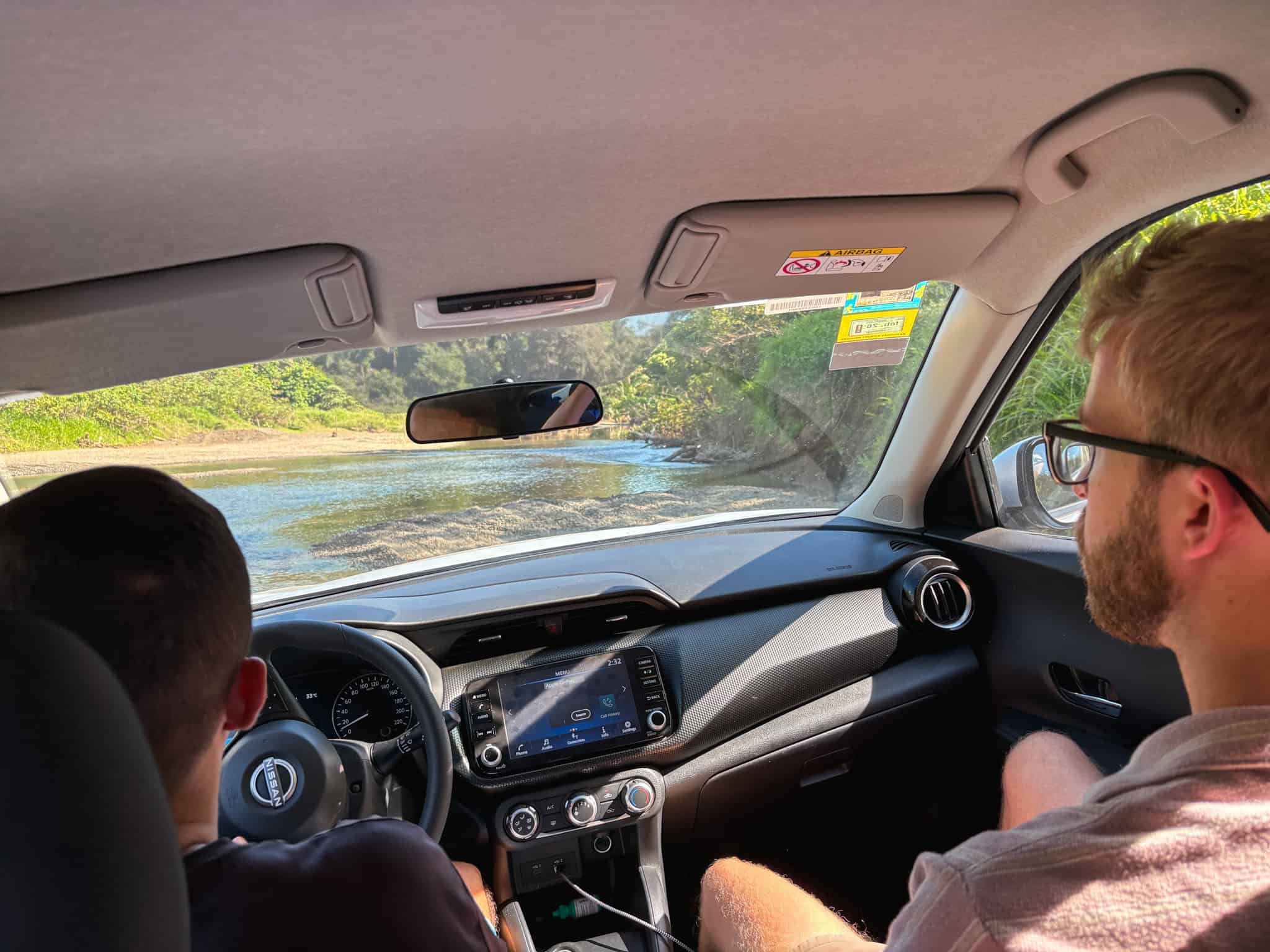
This depends on where you’re planning on driving in Costa Rica. At a minimum, I would highly recommend renting an SUV. It’s extremely likely you’ll run into unpaved roads, often with steep hills, and you’ll need a car with good clearance that’s built for off-roading.
If you’re primarily driving on highways and paved routes between cities, then you can manage without 4 wheel drive. We went from San José to Uvita to Arenal/La Fortuna to Santa Teresa without a 4×4. The main roads are quite accessible, it’s when you want to venture beyond that that you’ll want 4WD.
Places in Costa Rica where you need a 4×4

Airbnbs in the Hills
If you’re staying or exploring anywhere off the main road you’re going to want a 4×4. There are many beautiful homes with stunning outlooks that are completely inaccessible without four wheel drive. Our Airbnb in Uvita was at the end of about a mile of unpaved, steep hills, and there’s literally no way we could have accessed it without our friend’s 4×4.
Monteverde
The main road into Monteverde has been improved and is now paved, but once you’re there, it’s a different story. Many roads within Monteverde are still steep, rocky, and unpaved. If you’re planning to explore beyond the main drag (which you should, because the best spots require some effort), a 4×4 is the way to go.
✅ Paved access roads, but unpaved and rough inside Monteverde.
🚧 Steep inclines, potholes, and muddy conditions in the rainy season.
Santa Teresa & Surroundings
If you’re sticking to the main road and only driving to or from the airport, this is doable with an SUV. However, if you plan to take day trips to Montezuma, navigate to Cobano first and then Montezuma to stay on paved roads. Do not take any “shortcut” routes without a 4×4—Google Maps may suggest them, but they are often washed-out dirt roads or river crossings. I would have felt better if we’d had a 4×4 during our time here.
✅ Main roads paved, but side roads are dirt and full of potholes.
🚧 Rough terrain, potential river crossings, extremely bumpy roads.
Uvita Outskirts
The main highway is paved and smooth, but many Airbnbs and hotels are tucked away in the hills, accessible only by steep dirt roads. If you’re staying anywhere up in the mountains or plan to visit Nauyaca Waterfalls, get the 4×4.
✅ Paved coastal highway, but unpaved access roads to many hotels.
🚧 Steep inclines, muddy roads in the rainy season.
Dominical & Ojochal
Dominical itself is fine if you’re staying in town, but if your hotel or Airbnb is up in the jungle hills, you will need a 4×4. The same goes for Ojochal, where many eco-lodges and restaurants are perched on steep hills with unpaved access roads.
✅ Main road (Costanera Sur) is paved.
🚧 Hilly, rough dirt roads to jungle lodges and luxury rentals.
Nosara
The main town does not have fully paved roads, and getting there is a challenge. Expect dusty, unpaved roads with large potholes and river crossings. In the rainy season, Nosara’s roads turn into deep mud, making a 4×4 absolutely necessary.
✅ Paved in some areas, but rough in most.
🚧 Potholes, river crossings, and deep mud in rainy season.
Rincón de la Vieja National Park
If you’re visiting the more remote areas of Rincón de la Vieja, you will want a 4×4. Some of the hot springs, waterfalls, and lodges require driving on unpaved, bumpy roads. If you’re sticking to the Las Pailas sector, a regular car might be okay, but a 4×4 is safer, especially in wet conditions.
✅ Main highway to Liberia is fine, but park roads are rough.
🚧 Gravel roads, deep potholes, and slippery slopes in the rainy season.
Where do you not need a 4×4 in Costa Rica?
If you’re staying in these main areas, you shouldn’t need a 4×4. The roads are paved and well-maintained, making them easy to drive with a standard SUV.
San José
San José is a busy city with fully paved roads. Traffic jams are bigger issues than road conditions. If you’re just staying in the city before heading elsewhere, you do not need a 4×4. That being said, you should explore beyond San José 🙃
✅ Well-paved highways and city streets.
🚧 Traffic congestion and aggressive drivers, but no terrain issues.
Arenal / La Fortuna
The roads leading to and around Arenal are paved, making it accessible without a 4×4. Even most adventure parks and attractions—like La Fortuna Waterfall, Mistico Hanging Bridges, and Arenal National Park—are reachable without off-roading. I’ve got a complete guide to La Fortuna here for you.
✅ Paved roads throughout La Fortuna and to major attractions.
🚧 Some bumpy roads for remote hikes, but manageable without a 4×4.
Manuel Antonio
This is one of the easiest destinations to drive to. The highway to Manuel Antonio is fully paved, and even roads leading to the beach, national park, and most hotels are in great condition.
✅ Paved roads all the way to the national park and hotels.
🚧 Some narrow roads with steep inclines near hotels, but nothing extreme.
Jaco
The road to Jaco is fully paved, and driving here is straightforward. Unless you’re planning to explore off the beaten path, you won’t need a 4×4.
✅ Paved main road and highways.
🚧 Some dirt roads to waterfalls or secluded beaches, but manageable.
Liberia & Papagayo
Liberia is one of the easiest places to drive in Costa Rica. If you’re staying in Papagayo, Playa Hermosa, or Playa del Coco, the roads are fully paved, and a 4×4 isn’t needed at all.
✅ Modern roads and highways.
🚧 No major road challenges.
Tamarindo & Playa Flamingo
Tamarindo has fully paved roads, and the same goes for Playa Flamingo and Playa Conchal. If you’re just staying in resorts, hotels, or central areas, a standard car is completely fine.
✅ Paved roads in and around town.
🚧 Some dirt roads to more remote beaches, but an SUV is enough.
Puerto Viejo
The drive from San José to Puerto Viejo is fully paved. You only need a 4×4 if you’re exploring remote beaches like Playa Manzanillo or hidden jungle lodges.
✅ Paved road all the way from San José to Puerto Viejo.
🚧 Some rough roads to more secluded beaches, but nothing major.
Renting a Car in Costa Rica: What You need to Know Ahead of Time
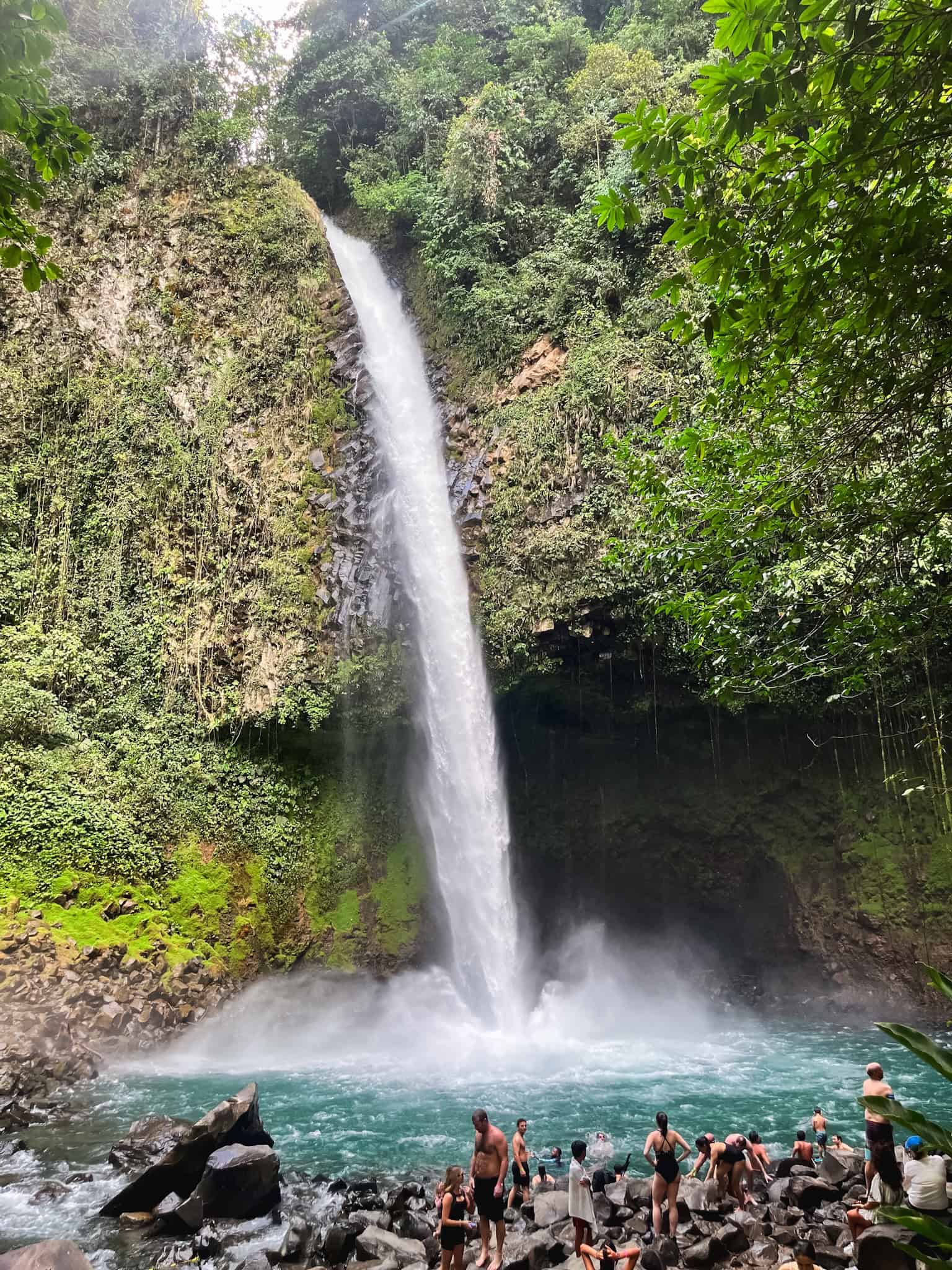
I was really happy we ended up renting a car in Costa Rica because it really is the best way to explore the country on your own schedule.
While shuttle services and domestic flights are readily available, having your own car gives you the freedom to visit hidden beaches, drive up to scenic Airbnbs, and take spontaneous detours to waterfalls (Fortuna Waterfall was my favorite!).
That said, there are some quirks to renting a car in Costa Rica—from mandatory insurance fees to unpaved roads—that you’ll want to be aware of before booking.
Cost to Rent a Car in Costa Rica
At first glance, renting a car in Costa Rica looks cheap—you’ll see rates as low as $40 per day. But once you factor in mandatory insurance, taxes, and additional fees, the total cost is much higher.
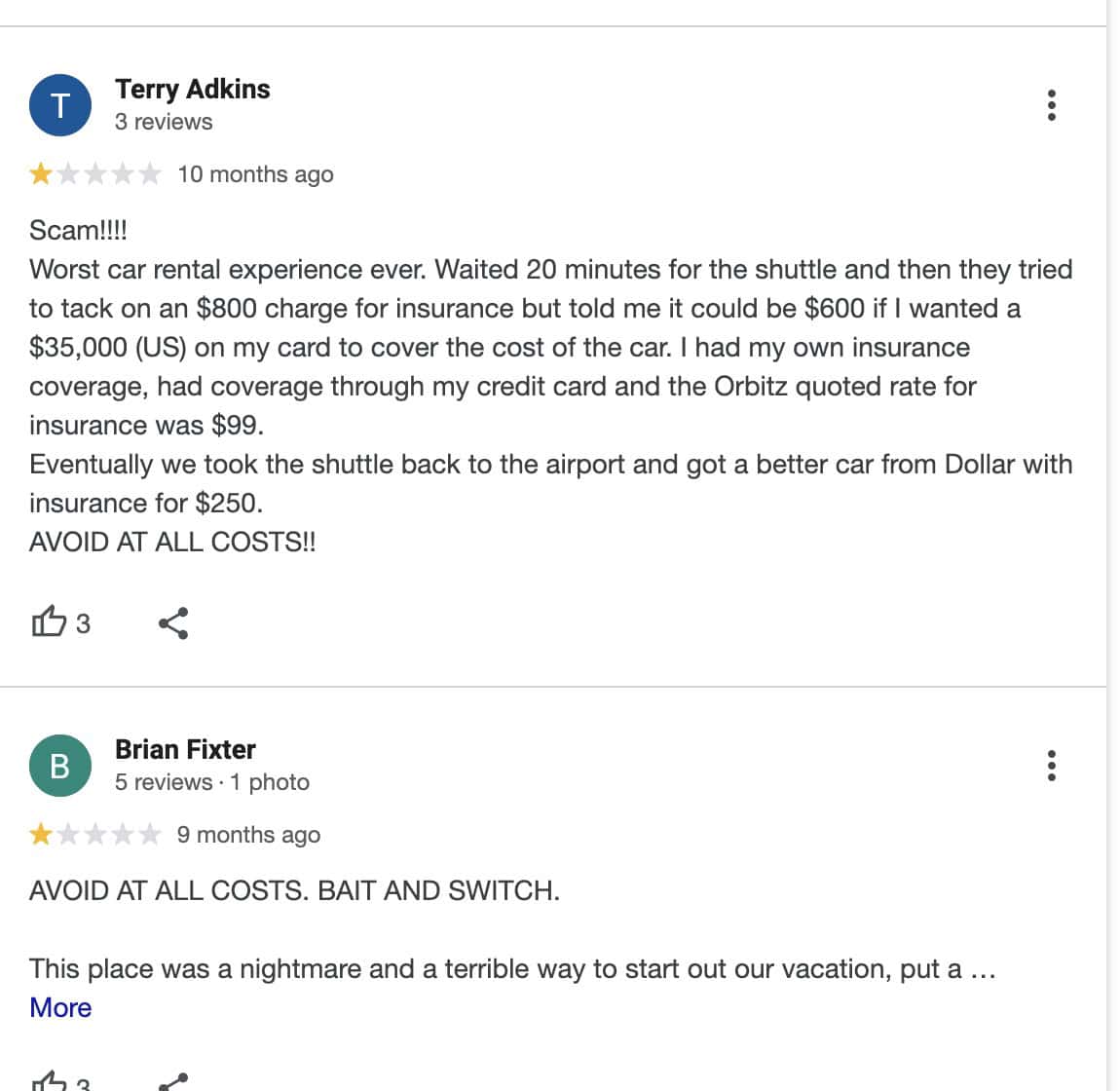
It’s also critical that you rent through a reliable company that won’t hit you with surprise fees once you arrive. I would recommend booking through a vendor like DiscoverCars (which often has discounts like these on car rentals) and choosing Adobe, Vamos, Sixt or any U.S. national chain (we used Avis).
If you don’t recognize the car rental company, I would strongly encourage you to google them before booking. Some companies (like Fox) have super affordable rates but when you dig a little deeper, the reviews are scathing. You would not want to be stuck dealing with that when you land in Costa Rica.
We picked up our car rental in San José because there are so many car rental agencies at the airport. We then did a one-way with a drop off in Santa Teresa because we planned on flying back to SJO in a few weeks. Not all companies offer this one way service in Costa Rica, but Avis does.
💰 What We Paid: For one week in Costa Rica, our rental car totaled around $650, which included:
✔ Base rental price ($40 per day for an SUV)
✔ Mandatory Third-Party Liability Insurance (TPL) ($30+ per day – more on this below)
✔ One way charge ($100)
✔ Taxes and fees
Cheapest Car Rentals in costa rica
👉 Check out DiscoverCars here for the most affordable car rentals in Costa Rica. Make sure you GOOGLE the rental company before you book, or go with a brand you recognize! I booked Avis.
Costa Rica Car Rental Insurance: Yes, You Have to Buy It
Unlike in the U.S., Costa Rica requires all drivers to have Third-Party Liability Insurance (TPL), and your credit card insurance won’t cover this. Even if your credit card provides primary or secondary rental insurance, it does not include the legally required liability coverage, and rental companies won’t let you decline it.
We brought a printout from our credit card company (Chase) indicating our coverage and our Avis rep flatly told us he would wait while we called the bank because it would not be accepted (so he was clearly used to this argument). I straight out asked if we would be able to rent the car without buying the insurance and he said no.
While this unexpected expense was annoying (I thought I was so prepared with my credit card printout), at the end of the day I was glad to know we wouldn’t be in any legal hot water if we got in an accident on the road.
Alternative to Driving in Costa Rica: Shuttles and ATVs
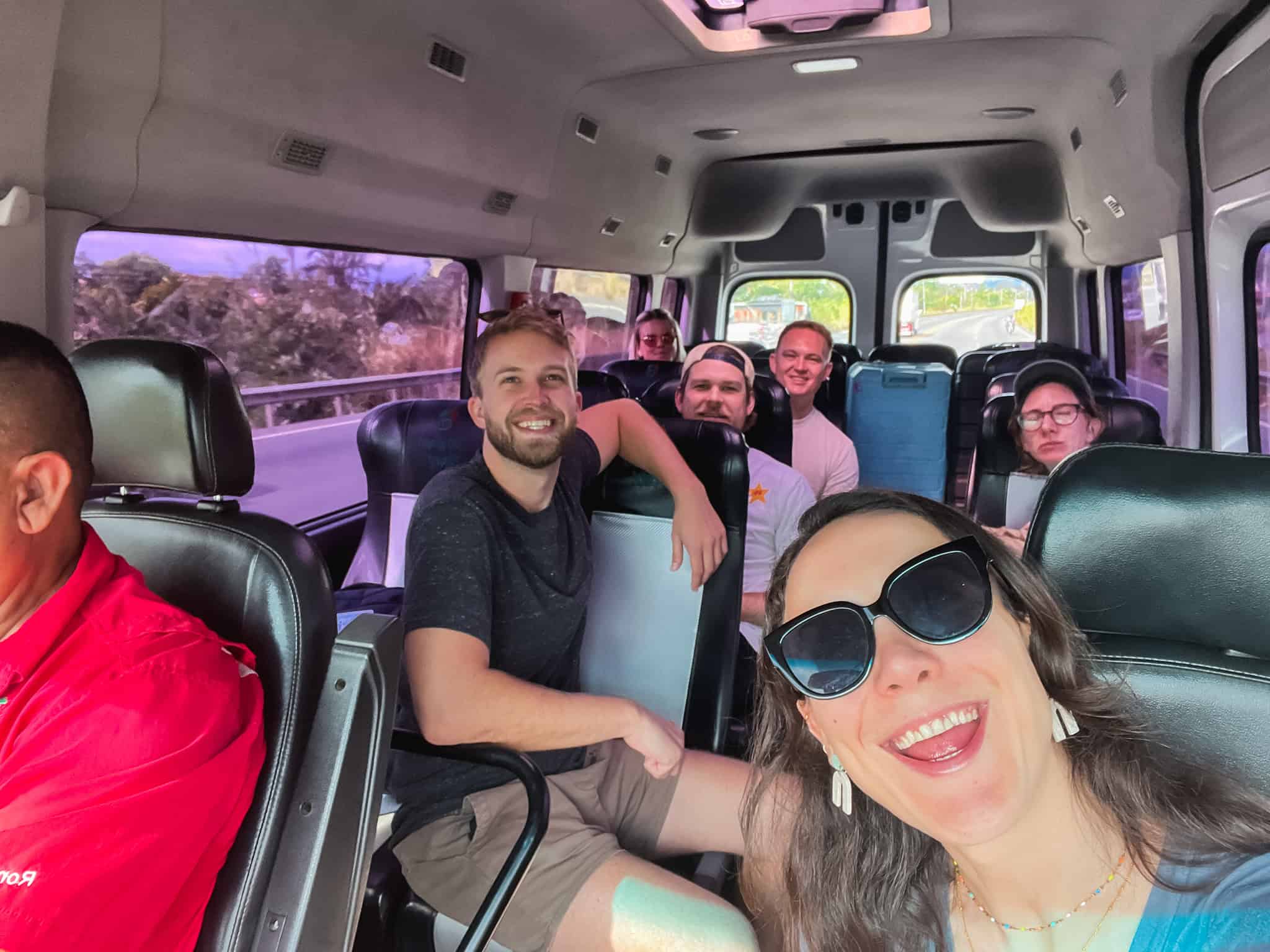
Not sold on renting a car? No problem—there are other ways to get around Costa Rica, depending on your budget, itinerary, and sense of adventure.
If you’re looking for a stress-free way to move between cities, shuttles are a great option (our driver, Ronnie, was awesome). If you’re in a beach town and want something fun and practical, ATVs are incredibly popular (albeit expensive) and honestly, pretty fun to drive.
Shuttles: The Easy, No-Stress Option
If you don’t want to deal with driving, navigating potholes, or figuring out car rental insurance, taking a shuttle is the easiest way to get around Costa Rica.
Shuttle companies run daily routes between all the major tourist destinations, and the service is usually seamless. You’ll be in an air-conditioned van, the drivers are professional, and you don’t have to worry about anything other than getting to your next adventure.
I used shuttles for the first part of our trip when 6-8 of us were shuttling to and from San Jose and Uvita, and it didn’t make sense to rent a car that large.
Shuttle pricing depends on whether you go shared or private. A shared shuttle will run about $60 per person, while a private shuttle for your group is closer to $300. If you’re traveling solo, a shared shuttle is a great budget-friendly option, but for couples or groups, splitting a private shuttle can be worth it for the convenience alone.
There are many options with good reviews here on GetYour Guide, or Interbus is a common local shuttle company you can book.
We saw plenty of travelers using shuttles to get between San José, La Fortuna, Tamarindo, and Manuel Antonio. If you’re sticking to these areas, will be doing guided tours with pickups, and don’t plan to go off the beaten path, you really don’t need a car.
ATVs: The Beach Town Favorite
Now, if you’re headed to a beach town like Santa Teresa, Nosara, or Montezuma, you’ll quickly notice that pretty much everyone is driving ATVs. Renting a car in these towns can be a pain, and since many of the roads are unpaved, hilly, and full of potholes, ATVs have become the go-to mode of transport.
For beach towns like these, you could take a shuttle to/from the airport, and rent an ATV for the days you want it in town.
I honestly enjoying renting ATVs. They’re easy to drive, you can take them off-road, and they’re small enough to navigate through town without stressing about parking. Unfortunately, they’re not cheap. An ATV rental will run around $80 per day.
To find one to rent, just type “ATV” into Google Maps when you get to town – you’ll find a lot of options and generally don’t need to reserve one in advance.
A word of caution: beach town roads kick up some serious dust. We learned very quickly that having a handkerchief or buff to cover your face is a must, especially in the dry season. If you’re planning to use an ATV for longer rides (like going from Santa Teresa to Montezuma), bring sunglasses and something to cover your mouth and nose, or you’ll be inhaling dust the entire way.
While ATVs are fun, they’re not great for long distances. They’re solid for getting around town or making short trips to nearby beaches, but if you need to cover real ground, you’re better off with a car or shuttle.
Driving in Costa Rica: Final Thoughts
Driving in Costa Rica was an adventure, but one that I would repeat again. Next time we visit, I’ll definitely try to get a 4X4 (if only for peace of mind) and I’ll be prepared for the insurance fees.
Cheers to your next adventure and Pura Vida!






